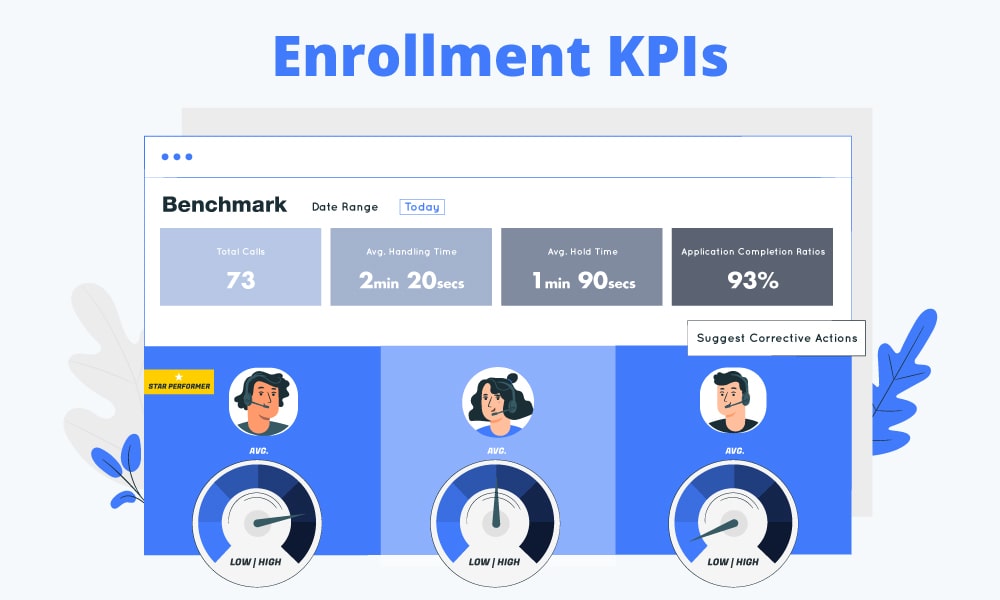
Higher institutions have goals for different departments, including Enrollment. Hence, the need for an enrollment management strategic plan to guide the team. But the biggest challenge for marketers and admission officials is to measure its effectiveness.
Success in higher education marketing depends on various metrics known as KPIs (Key Performance Indicators). With KPIs in place, you can hit your goals with ease.
Read on to learn why KPIs are integral to higher education enrollment. Also, discover the most vital metrics as per your admission goals.
You can also keep these KPIs in your roadmap for strategic enrollment management planning.
Why are KPIs important?
KPIs help make sense of your marketing campaigns across different channels. You can track and analyze them to get deeper insights. It indicates how close or far away you are from your goals.
Let us say one of your goals is to increase the number of enrollments in the Data Science department by 15%. You can use the number of visits to the website or the number of inquiries to determine the effectiveness of your current campaign. Higher visits mean that more people show interest in studying Data Science. If the numbers are lower, you will need to tweak the campaign.
In general, your progress is trackable when there are KPIs to benchmark.
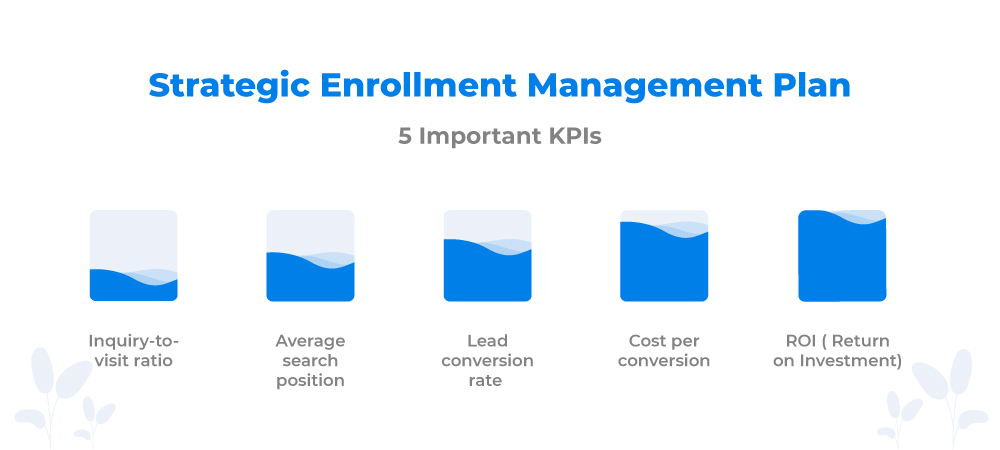
5 Important KPIs to track in your enrollment management strategic plan
There are many KPIs that marketers can track, depending on the school. The following are the crucial KPIs to track to increase the number of enrollments.
1. Inquiry-to-visit ratio
There is more to higher education marketing than just high website visits. Website visits are vital, but tracking the rate at which these visits are turning into verified leads is more important. Hence you should also focus on the inquiry-rate metric.
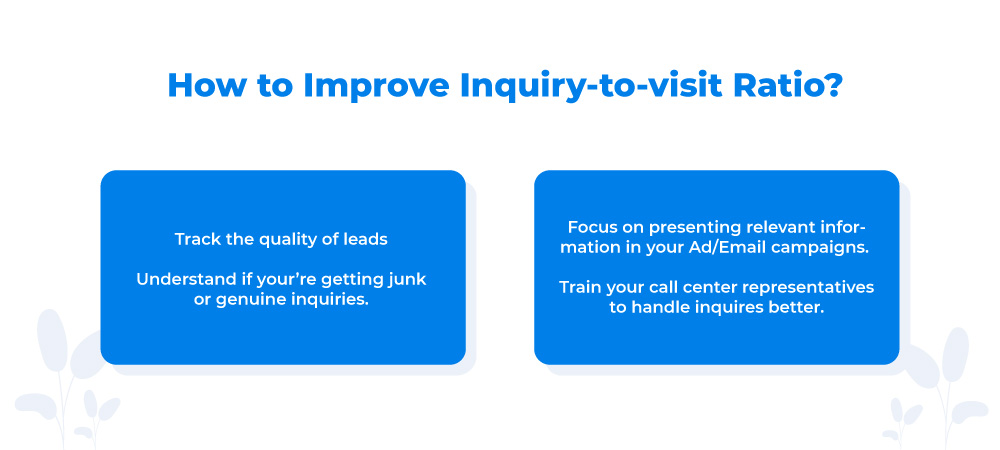
The US in 2018 saw a 7% decline in inquiry volume across academic programs and institutions. Focusing on this metric will show you what matters. For example, how many students are filling the forms on your website or sending inquiry emails? How many students are placing calls to your institution?
The lower the inquiry rate, the lesser are your chances of enrolling more students.
You can experience low inquiry rates for various reasons. One big reason is that you are bringing the wrong audience to your website.
For instance, if your school offers only online courses, ensure that your ads say that in clear terms. Else, you will attract prospects who most likely want to study on-campus. The messaging on your content should target a particular audience. It will help in increasing the quality of your leads.
Another reason high visits can result in lower inquiries is a lack of relevant information. Students are thorough when choosing a school, especially when the options are plenty. Students want answers from your website. The top of the list is why they should attend your school.
Researching your audience helps in understanding their pain points. Then, you can use these challenges to create valuable content across your channels.
2. Average Position on Search Results
The higher education sector is very competitive. Hence, one metric to keep an eye on is your average position in search results. It indicates the level of your visibility online. It also measures the average ranking of your school for specific search queries.
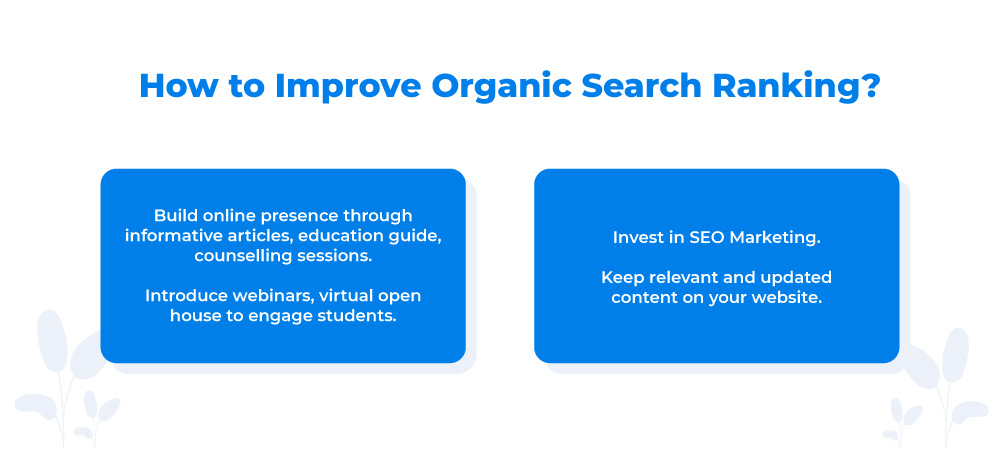
You are more likely to get your fair share of leads if your website’s URLs appear on the first page of search results. It is also the reason why many schools invest in search engine optimization (SEO). Also, because 67% of students use search engines when researching schools.
With SEO marketing, you can decide which keywords you want to rank for on search engines. The higher and frequent your content appear on search results, the better. It will strengthen your authority online. It will also unlock opportunities to sell to more prospective students.
3. Lead conversion rate
Optimizing the Lead-to-enrollment time is one of the biggest challenges for us, says Sarah Holmes, Director of Admissions, Bellus Academy.
(Source: https://www.bellusacademy.edu/blog/what-to-expect-during-the-admission-process/)
Lead conversion metric is vital for your enrollment management strategic plan because it shows the ratio of leads or visitors who take the desired action on your website. Conversion in this context does not necessarily mean becoming a student. Instead, it depends on the stage of the enrollment funnel.
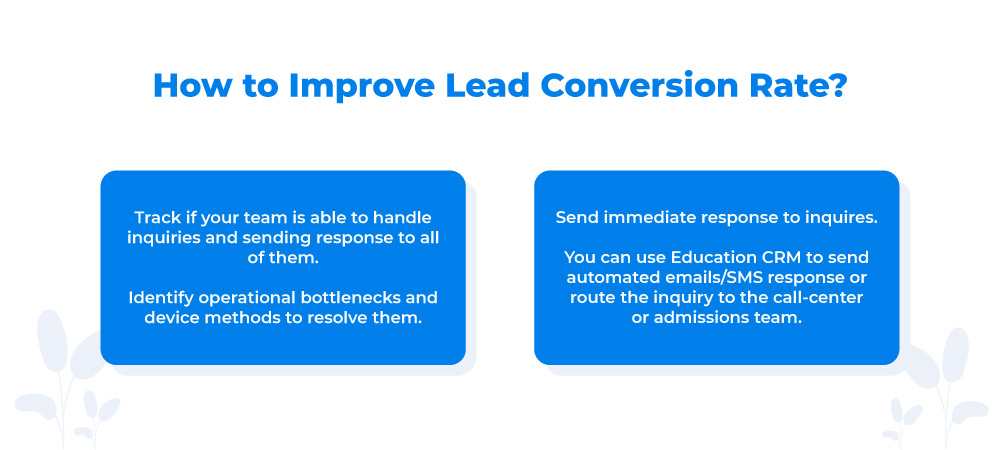
You can devise your enrollment management communication plan. It can be something as simple as registering for a webinar. Let us say you write a long piece of article on your university blog.
At the end of the article, you ask the reader to attend an upcoming webinar (CTA or “call to action”). The conversion rate is the percentage of people who register as against the number of people who visited the page.
Tracking this metric helps to understand whether the marketing works. If the current marketing strategy is not working, then you’ll need to revamp it. In the example above, it can be rewriting the blog more interestingly, or it can also be making the CTA more inspiring to click.
4. Cost per conversion
As a higher education marketer, you want to see returns on your expenditure. Cost per conversion is the total amount spent in convincing a prospect to take admission. For instance, it can tell you the average expense on all your completed applications.
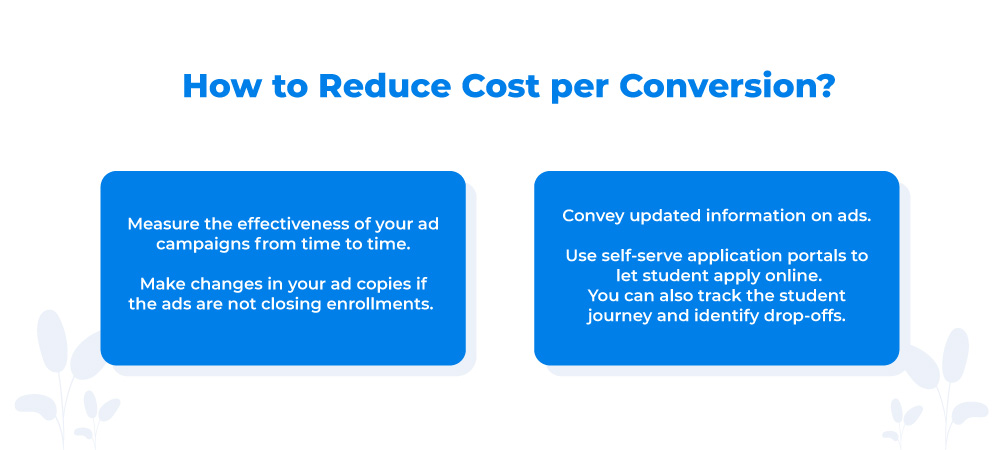
But you can streamline the calculation by considering the cost per lead factor. You can get this by dividing your total expenditure by the number of leads acquired. Here, you will consider every cent spent on SEO, PPC, Content Marketing, to name some.
You need to measure this KPI because conversions contribute to the bottom line. With this metric, you can also understand the performance of your ad campaigns. If you are spending too much on ads and getting little to no results, you might want to review ad campaigns.
5. Return on investment (ROI)
ROI is the ultimate metric for every business, including higher education. High ROIs generally signal the effectiveness of your enrollment management strategies. You want to keep an eye on this metric as it also ties into your bottom line. It also measures performance across all your channels, which can be online or offline.
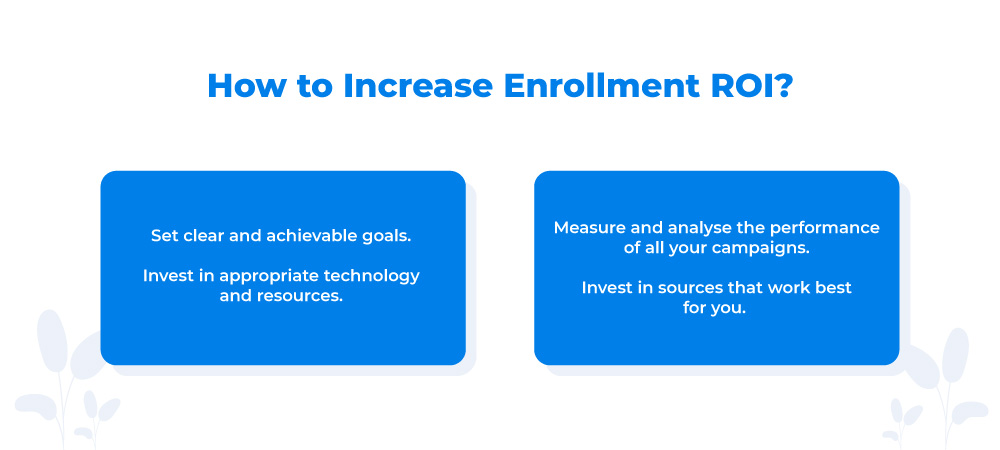
Measuring ROI also helps to connect the dots between marketing and management. Marketers who focus on content marketing, may find it more difficult to measure the enrollment ROI. There are different ways to measure your impact (Skyword Inc.).
- Content grouping: It helps you assign attribute value to each specific piece of content and measure its impacts considering interactions, website traffic, and goal completion tracking.
- Saved Ad spent: If you are investing in building your online presence through SEO, then the amount of money you save in ads is another ROI that you can achieve.
- Valued steps: Even if your organic marketing efforts are not leading to admissions, but directing your prospective students to call your admissions team, then you can calculate values from fractional conversion costs.

Meeting your enrollment goals using higher education CRM
Your enrollment management strategic plan should serve as a guide for successful marketing. In 2015, 58% of higher education admissions directors could not achieve their enrollment goals. One of the reasons for this is due to the unavailability of relevant tools.
But today, with CRM tools specially designed for the education sector, it is possible to achieve your admission goals. For example, the Tricoci University of Beauty Culture, the United States, was able to increase its process efficiency by 75% after using the LeadSquared Education CRM – resulting in increased enrollments even during the pandemic.
All the metrics mentioned earlier are easy to measure when you can balance online and offline behavior. One of the ways to do it is by adopting a CRM software. It considers the entire customer journey offline while also integrating with your other digital tools.
For example, a prospective student can start their application online through self-serve portals and still reach out to an admissions rep via phone call during their application. CRMs bring everything into full view without missing any channel.
LeadSqaured’s CRM can help you put in place your enrollment management strategic plan.
Further reading:
Student Enrollment FAQs
Enrollment management in educational institutions is the process of recruiting students. It involves marketing, sales, counseling, and financial advisory teams and online and offline strategies to support students in their admissions journey. Best Practices.
A strategic plan in higher education involves setting clear u0026 achievable goals, tracking KPIs, defining processes, and having a team to execute the plan.
To increase your college enrollment, you need to think from your students’ perspectives. Understanding what drives your prospects will help you create better marketing messages, ad copies, and admissions pitch that resonates with the aspirations of your applicants and promotes action. 10 Tips.








